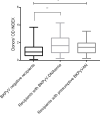Pretransplantation seroreactivity in kidney donors and recipients as a predictive factor for posttransplant BKPyV-DNAemia
- PMID: 35967393
- PMCID: PMC9364833
- DOI: 10.3389/fimmu.2022.929946
Pretransplantation seroreactivity in kidney donors and recipients as a predictive factor for posttransplant BKPyV-DNAemia
Abstract
BK polyomavirus (BKPyV) often reactivates after kidney transplantation, causing BKPyV-associated nephropathy (BKPyVAN) in 1%-10% of cases with a potential detrimental effect on allograft survival. Kidney transplant recipients are regularly screened for BKPyV DNA in plasma. As this strategy may not always reduce the risk of BKPyVAN, other predictive markers are needed. To evaluate the role of pretransplant BKPyV-specific antibody, 210 kidney transplant recipients and 130 donors were screened for BKPyV DNA and BKPyV-specific antibodies. We found that the donor BKPyV immunoglobulin G (IgG) seroprevalence and antibody level were strongly associated with BKPyV-DNAemia and BKPyVAN, although multivariant analysis found the presence of anti-BKPyV-specific antibodies as a predictive factor only for BKPyV-DNAemia. The pretransplant recipient status had no effect on posttransplant BKPyV-DNAemia and BKVAN. BKPyV IgG levels remained stable in BKPyV-negative recipients during 1-year follow-up, while a considerable increase was observed in BKPyV-positive patients. The presence of anti-BKPyV-specific antibodies in kidney allograft donors is a good and reliable predictive marker for posttransplant BKPyV replication with relevance to risk stratification in transplant recipients.
Keywords: BK polyomavirus (BKPyV); BKPyV-associated nephropathy; kidney transplantation; seroprevalence; seroreactivity.
Copyright © 2022 Saláková, Ludvíková, Hamšíková, Kolářová, Šroller, Viklický and Wohlfahrtová.
Conflict of interest statement
The authors declare that the research was conducted in the absence of any commercial or financial relationships that could be construed as a potential conflict of interest.
Figures






Similar articles
-
Pretransplantation Donor-Recipient Pair Seroreactivity Against BK Polyomavirus Predicts Viremia and Nephropathy After Kidney Transplantation.Am J Transplant. 2017 Jan;17(1):161-172. doi: 10.1111/ajt.13880. Epub 2016 Jul 8. Am J Transplant. 2017. PMID: 27251361
-
BK polyomavirus serotype-specific antibody responses in blood donors and kidney transplant recipients with and without new-onset BK polyomavirus-DNAemia: A Swiss Transplant Cohort Study.Am J Transplant. 2025 May;25(5):985-1001. doi: 10.1016/j.ajt.2024.11.019. Epub 2024 Nov 22. Am J Transplant. 2025. PMID: 39580075
-
The risk factors associated with post-transplantation BKPyV nephropathy and BKPyV DNAemia: a prospective study in kidney transplant recipients.BMC Infect Dis. 2024 Feb 22;24(1):245. doi: 10.1186/s12879-024-09093-7. BMC Infect Dis. 2024. PMID: 38388351 Free PMC article.
-
BK polyomavirus-specific antibody and T-cell responses in kidney transplantation: update.Curr Opin Infect Dis. 2019 Dec;32(6):575-583. doi: 10.1097/QCO.0000000000000602. Curr Opin Infect Dis. 2019. PMID: 31567736 Review.
-
The Second International Consensus Guidelines on the Management of BK Polyomavirus in Kidney Transplantation.Transplantation. 2024 Sep 1;108(9):1834-1866. doi: 10.1097/TP.0000000000004976. Epub 2024 Apr 12. Transplantation. 2024. PMID: 38605438 Free PMC article. Review.
Cited by
-
Neutralizing Antibodies Targeting BK Polyomavirus: Clinical Importance and Therapeutic Potential for Kidney Transplant Recipients.J Am Soc Nephrol. 2024 Oct 1;35(10):1425-1433. doi: 10.1681/ASN.0000000000000457. Epub 2024 Jul 9. J Am Soc Nephrol. 2024. PMID: 39352862 Review.
-
Pretransplant BKV-IgG serostatus and BKV-specific ELISPOT assays to predict BKV infection after kidney transplantation.Front Immunol. 2023 Sep 21;14:1243912. doi: 10.3389/fimmu.2023.1243912. eCollection 2023. Front Immunol. 2023. PMID: 37809095 Free PMC article.
References
Publication types
MeSH terms
Substances
LinkOut - more resources
Full Text Sources
Medical
Research Materials

